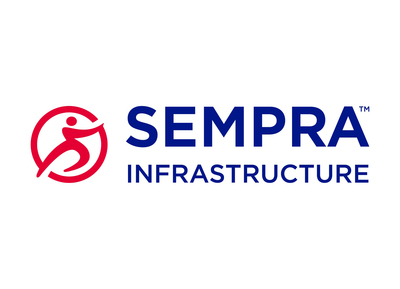HOUSTON, Feb. 2, 2024 /PRNewswire/ -- Sempra Infrastructure, a subsidiary of Sempra (NYSE: SRE) (BMV: SRE), today announced that it has entered into a memorandum of understanding (MOU) with the Japan Bank for International Cooperation (JBIC) to cooperate on opportunities to advance the energy transition. Through this MOU, Sempra Infrastructure and JBIC aim to further project structuring to improve the global energy supply chain through liquefied natural gas (LNG), hydrogen and other decarbonization efforts in both the United States and Japan.
"Sempra Infrastructure is thrilled to expand its collaboration with JBIC as we look forward to advancing projects that lower the carbon intensity of our energy delivery assets in North America," said Justin Bird, CEO of Sempra Infrastructure. "We have built our relationships with customers and the export credit agencies in Japan over the past decade and are excited to expand our relationship with JBIC as we continue developing projects in support of our net-zero business. This collaboration will help us continue advancing our mission of developing energy infrastructure that provides access to safe, secure and affordable energy to our global partners."
The Sempra family of companies have partnered in various ways with Japanese companies for half a century. More recently, these partnership efforts are reflected in Sempra Infrastructure's Cameron LNG facility and recently announced strategic collaboration with a Japanese consortium, which calls for an evaluation of potential enhancements of the energy supply chain in support of decarbonization through e-natural gas as part of the ReaCH4 Project. In addition, the company is developing the Hackberry Carbon Sequestration Project, which contemplates the participation of two Japanese companies. Both development projects are in close geographical proximity to the Cameron LNG facility.
The U.S. Department of Energy and Japan's Ministry of Economy, Trade and Industry are currently implementing a Memorandum of Cooperation (MOC) in the field of carbon capture, storage, conversion and recycling, and carbon dioxide removal. The MOU between Sempra Infrastructure and JBIC is intended to help Sempra Infrastructure and its customers in Japan meet many of the objectives of the MOC and helps support further efforts between the two countries to advance decarbonization efforts. As Japan's policy-based financial institution, JBIC has articulated a mission to continue to financially support the creation of business opportunities for Japanese companies and the securing of a stable supply of energy.
The referenced MOU is a preliminary, non-binding arrangement, and the development of any project in connection with the MOU is contingent upon completing the required commercial agreements, securing and/or maintaining all necessary permits, obtaining financing, and reaching a final investment decision, among other factors and considerations.
About Sempra Infrastructure
Sempra Infrastructure, headquartered in Houston, is focused on delivering energy for a better world by developing, building and operating, and investing in clean power, energy networks, and LNG and net-zero solutions that are expected to play a crucial role in the energy systems of the future. Through the combined strength of its assets in North America, Sempra Infrastructure is connecting customers across the globe to modern energy infrastructure to source and transport renewables and natural gas, while advancing carbon sequestration and clean hydrogen. For more information about Sempra Infrastructure, please visit www.SempraInfrastructure.com and social media.
This press release contains forward-looking statements within the meaning of the Private Securities Litigation Reform Act of 1995. Forward-looking statements are based on assumptions about the future, involve risks and uncertainties, and are not guarantees. Future results may differ materially from those expressed or implied in any forward-looking statement. These forward-looking statements represent our estimates and assumptions only as of the date of this press release. We assume no obligation to update or revise any forward-looking statement as a result of new information, future events or otherwise.
In this press release, forward-looking statements can be identified by words such as "believe," "expect," "intend," "anticipate," "contemplate," "plan," "estimate," "project," "forecast," "should," "could," "would," "will," "confident," "may," "can," "potential," "possible," "proposed," "in process," "construct," "develop," "opportunity," "initiative," "target," "outlook," "optimistic," "poised," "maintain," "continue," "progress," "advance," "goal," "aim," "commit," or similar expressions, or when we discuss our guidance, priorities, strategy, goals, vision, mission, opportunities, projections, intentions or expectations.
Factors, among others, that could cause actual results and events to differ materially from those expressed or implied in any forward-looking statement include: decisions, investigations, inquiries, regulations, denials or revocations of permits, consents, approvals or other authorizations, and other actions by the (i) U.S. Department of Energy, Comisión Reguladora de Energía, U.S. Federal Energy Regulatory Commission, U.S. Internal Revenue Service and other governmental and regulatory bodies and (ii) U.S., Mexico and states, counties, cities and other jurisdictions therein and in other countries where we do business; the success of business development efforts, construction projects, acquisitions, divestitures and other significant transactions, including risks in (i) being able to make a final investment decision, (ii) completing construction projects or other transactions on schedule and budget, (iii) realizing anticipated benefits from any of these efforts if completed, and (iv) obtaining third-party consents and approvals; macroeconomic trends or other factors that could change our capital expenditure plans and their potential impact on growth; litigation, arbitrations, property disputes and other proceedings, and changes to laws and regulations, including those related to tax and trade policy and the energy industry in Mexico; cybersecurity threats, including by state and state-sponsored actors, of ransomware or other attacks on our systems or the systems of third parties with which we conduct business, including the energy grid or other energy infrastructure, all of which continue to become more pronounced; the availability, uses, sufficiency, and cost of capital resources and our ability to borrow money or otherwise raise capital on favorable terms and meet our obligations, including due to (i) actions by credit rating agencies to downgrade our credit ratings or place those ratings on negative outlook, (ii) instability in the capital markets, or (iii) rising interest rates and inflation; failure of foreign governments, state-owned entities and our counterparties to honor their contracts and commitments; the impact on our ability to pass through higher costs to customers due to volatility in inflation, interest and foreign currency exchange rates and commodity prices; the impact of climate and sustainability policies, laws, rules, regulations, disclosures and trends, including actions to reduce or eliminate reliance on natural gas, the risk of nonrecovery for stranded assets, and our ability to incorporate new technologies; weather, natural disasters, pandemics, accidents, equipment failures, explosions, terrorism, information system outages or other events that disrupt our operations, damage our facilities or systems, cause the release of harmful materials or fires or subject us to liability for damages, fines and penalties, some of which may not be recoverable through insurance or may impact our ability to obtain satisfactory levels of affordable insurance; the availability of natural gas, including disruptions caused by failures in the pipeline system or limitations on the withdrawal of natural gas from storage facilities; and other uncertainties, some of which are difficult to predict and beyond our control.
These risks and uncertainties are further discussed in the reports that Sempra has filed with the U.S. Securities and Exchange Commission (SEC). These reports are available through the EDGAR system free-of-charge on the SEC's website, www.sec.gov, and on Sempra's website, www.sempra.com. Investors should not rely unduly on any forward-looking statements.
Sempra Infrastructure and Sempra Infrastructure Partners are not the same company as San Diego Gas & Electric Company or Southern California Gas Company, and none of Sempra Infrastructure, Sempra Infrastructure Partners nor any of its subsidiaries is regulated by the California Public Utilities Commission.
 View original content to download multimedia:https://www.prnewswire.com/news-releases/sempra-infrastructure-and-japan-bank-for-international-cooperation-to-develop-strategic-collaboration-in-support-of-the-energy-transition-302051372.html
View original content to download multimedia:https://www.prnewswire.com/news-releases/sempra-infrastructure-and-japan-bank-for-international-cooperation-to-develop-strategic-collaboration-in-support-of-the-energy-transition-302051372.html
SOURCE Sempra Infrastructure
![]() View original content to download multimedia:https://www.prnewswire.com/news-releases/sempra-infrastructure-and-japan-bank-for-international-cooperation-to-develop-strategic-collaboration-in-support-of-the-energy-transition-302051372.html
View original content to download multimedia:https://www.prnewswire.com/news-releases/sempra-infrastructure-and-japan-bank-for-international-cooperation-to-develop-strategic-collaboration-in-support-of-the-energy-transition-302051372.html





